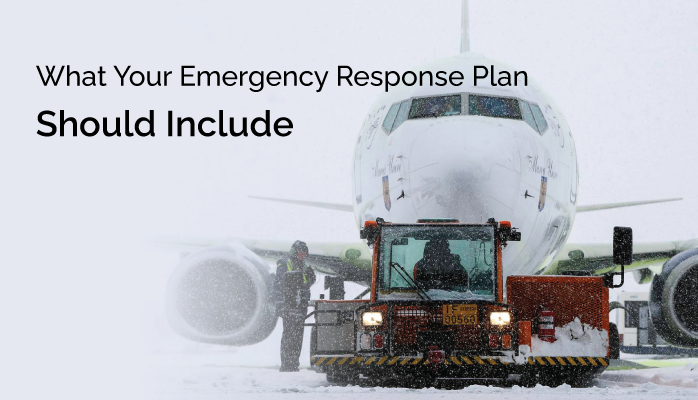What Is an Emergency Response Plan (ERP)

The actions employees take immediately in response to an emergency will greatly affect the outcome of the emergency. In such situations, employees’ actions may largely be the deciding factor between catastrophic consequences and a scary but benign outcome.
Consequences can be
- financial,
- environment,
- material, or
- personal (i.e.) loss of life.
Emergency response plans guide the type of behavior needed to avoid such consequences and mitigate the emergency. Unfortunately, the covered emergency in many (if not most) companies' ERPs is very incomplete.
An emergency response plan is generally compiled in a manual that includes:
- Who to contact in a given emergency;
- How to act; and
- Resources to use to mitigate the emergency.
The top priorities for an ERP are:
- Protection;
- Safe conduct;
- Stabilization of the dangerous condition; and
- Recovery.
ERPs are the pinnacle of high quality responsive risk management. An “emergency response plan” may also be called a “catastrophic situation plan.”
You Need to Know What “Emergency” Is in Aviation SMS
Incorrect understanding of an “emergency” is one reason why many organizations end up having an incomplete ERP. In the context of aviation SMS programs, an emergency should not simply be taken at its face value as a definition of “A serious, unexpected, and often dangerous situation requiring immediate action.”
Some emergencies are obvious and will easily be identified based on the above definition, such as:
- Bomb scares;
- Accident;
- Hijack;
- And so on.
In safety management systems, many “emergencies” will arise during the safety risk management process:
- Hazards are identified;
- For each hazard, potential risks (i.e., mishaps, accidents, etc.) are identified;
- These risks are assessed with a risk matrix.
At this point, you may identify “emergencies” that probably need to be included in your ERP.
- Some risks will have an assessment with a “catastrophic” severity;
- Such risks are emergencies; and
- Many of these risks should be included in your ERP.
In this manner, your ERP will include many more relevant emergencies than simply brainstorming “very dangerous situations.” Moreover, you can document that your ERP is generated from your SRM process and have a solid rationale for items in the ERP.
Related Aviation Risk Management Articles
- What Emergency Response Plans Are (and Why You Need It)
- Your Risk Management Attitude, Risk Response, and Emotional Intelligence
- Steps to Create an Emergency Response Plan in Aviation SMS [With Free Checklists]
Why Most Emergency Response Plans Are Incomplete
Most emergency response plans are incomplete for several reasons, all of which significantly expose organizations to the potential of significant damages. The most common reasons are:
- Creating complete ERPs is a lot of work, and safety management has not done this work;
- Incorrect understanding of what an emergency is (discussed previously);
- Does not include all needed information (see next); and
- Not enough guidance for proper behavior in each emergency.
ERPs that are complete are quite extensive. They should be long enough that it is unrealistic for employees to memorize different emergencies, but short enough that the ERP can quickly be consulted and understood in a given emergency.
Information Your Emergency Response Plan Should Include

Emergency response plans should be organized in two primary ways:
- “Chapters,” which will organize emergencies by their type, such as Fire, Terrorism, Reputation, etc.; and
- “Sub-Chapters,” each of which constitutes a specific emergency within a Chapter;
Organizations may add more custom organizations beyond this but at the very least this will be a useful way to make the ERP easily accessible.
Each emergency should include the following information:
- A list of people to contact, in order, with contact numbers;
- The list of contact people might be organized by Chapter, or by specific emergency
- The safety duties and responsibilities of each role in the company for a given emergency;
- Procedural actions required to maintain safety;
- Procedural actions required to mitigate the danger;
- Procedural actions required to recover from the emergency, such as cleanup; and
- What resources are best used to mitigate the emergency?
This information will be in a physical manual or a virtual manual, such as in an aviation safety management software or on a company server, or documented in multiple ways, thus allowing easy access.
Types of Emergencies Your Emergency Response Plan Should Include
It’s a little fruitless to describe the various emergencies that your ERP should include because each organization’s emergencies will be in response to its unique hazard and risk analysis activities. It is most worthwhile to say:
- Your emergencies will be diverse;
- You will have emergencies that might surprise you as being “emergencies,” such as:
- Sexual harassment;
- Fraud;
- Various I.T. problems (server loss, data loss, etc.);
- And so on.
- Common emergencies like “Bomb threat,” “Fire,” “Hijack,” “Collision,” etc., will only be some of the emergencies in your ERP.
The question then remains do you know if your ERP is complete? First of all, your ERP will always continue to grow and change as you review it and add additions. Secondly, if your ERP accounts for all identified catastrophic-risk situations related to hazards, and includes all discussed types of information, then it should be adequately complete.
You will also find these resources very helpful for your ability to manage your SMS program:
Last updated Jan 2025.







